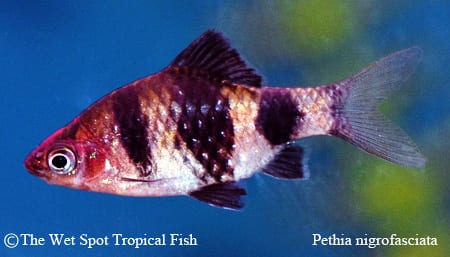Shaolin Monkfish
Shaolin Monkfish
How was your first week of the New Year? No, we haven’t lost time. We’re speaking, of course, of the Chinese New Year. One of the world’s most prominent festivals, billions around the world celebrate the annual start of the lunisolar calendar with 15 days of festivities. Today, we pay homage to the rich, cultural traditions associated with this annual event. Our most festive species include Mesonoemacheilus triangularis, Pethia nigrofasciata, and Stenomelania torulosa.
Scientific NameMesonoemacheilus triangularis
Common NameZodiac Loach
Temperature / pH65 to 75°F / 6.0 to 7.5 pH
Native LocationSouthern India
Preferred DietOmnivorous
An integral part of Chinese culture, zodiac animals help determine fundamental parts of life from marriage compatibility to career fit. Hailing from the river Manimala, M. triangularis is known to locals as the “Zodiac Loach”. Reaching just over 2 inches in length, these loaches are long-bodied with pointed heads and prominent whiskers. Exhibiting dark bodies with golden triangular patterning, these loaches dragon dance across the substrate. Preferring clear, well-oxygenated streams and rivers, they do best in tanks resembling flowing streams with variable-sized water-worn rocks, sand, and fine gravel. Additional furnishing to provide a natural feel can include driftwood branches, caves, and boulders arranged to form multiple crannies. With variable aggression depending on their population of origin, caution is recommended when adding this species to established community tanks. These loaches are best kept in tanks with small, open-water-dwelling cyprinids, and no other bottom-dwellers. Omnivorous by nature, they feed mostly on invertebrates and zooplankton, with small amounts of vegetation. In captivity, they are easily fed dried foods of suitable size, with regular live and frozen offerings. Intolerant to build-up of organic waste, 30 to 50% weekly water changes are encouraged.
Scientific NamePethia nigrofasciata
Common NameBlack Ruby Barb
Temperature / pH68 to 80°F/ 5.5 to 7.0 pH
Native LocationSri Lanka
Preferred DietOmnivorous
|
Scientific NameStenomelania torulosa
Common NameChopstick Snail
Temperature / pH72 to 86°F / 5.0 to 7.0 pH
Native LocationIndonesia
Preferred DietAlgae, biofilm
Chinese New Year festivities begin as every family deep-cleans their home. This symbolises sweeping away ill fortune and making way for incoming good luck. As we aquarists well know, clean tanks bring better fortune than dirty ones, and while Chinese families are probably not cleaning with chopsticks, we are able to clean our tanks with “Chopstick Snails”. Highly efficient scavengers and substrate sifters, S. torulosa is a hardy snail native to the Sulawesi lake system of Indonesia. Fun to observe, these snails have a unique appearance, and reach about 2.5 inches with long, spike-shaped shells. Chopstick snails spend most of their time climbing terrain, or burrowing in substrate. Completely peaceful by nature, they can be kept in any community tank where they will not get eaten. Safe with plants, they prefer to munch algae, biofilm, decaying plants, and sift through substrate. When kept in mature tanks, they require very little supplemental food, but they will gladly consume dried and frozen meals. When housing invertebrates it is extremely important to keep their environments copper-free. Check medication and food labels to ensure they will not poison your snails.


